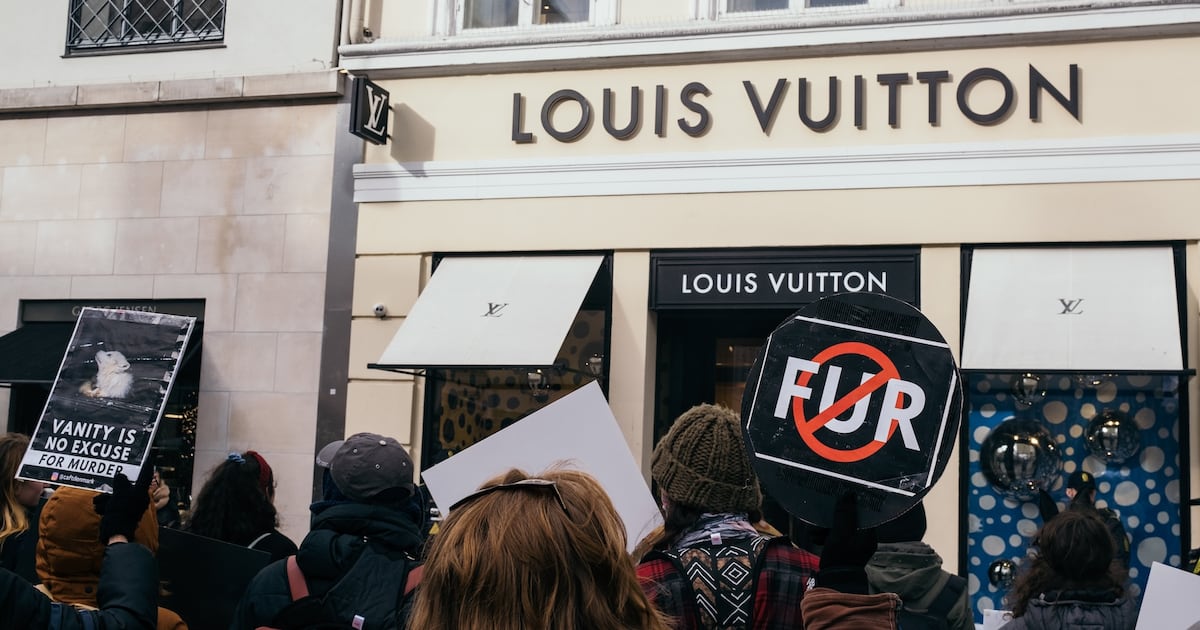Last year, the value of global fur exports fell to their lowest level since the early 2000s.
The trade in fur skins has been declining since it peaked at $14.7 billion in 2013, right before a flurry of major fashion brands said they were going fur free. Last year, the total value of global exports was just $3.4 billion, according to Euromonitor International, a near five-fold decline in the space of a decade.
The marketâs challenges arenât a passing trend. Decades of campaigning by animal rights advocates, increasingly powered by social media, have turned fur taboo in many Western consumer markets. In the first episode of the recently released rom-com series âNobody Wants This,â a character played by Kristen Bell turns up to a party in Los Angeles wearing a chinchilla coat. âWhat is this? What are you wearing? Itâs disgusting,â the host says to her. Turning to the rest of the party, Bell announces: âYou can relax, itâs fake.â
Gucci declared fur passé in 2017, joining Calvin Klein, Ralph Lauren, Tommy Hilfiger and Armani, which had all gone all fur-free, and spurring more brands to follow suit. Major retailers like Selfridges and Neiman Marcus also have no-fur policies. Glossy magazine Elle went fur-free in 2021.
Politicians have taken up the cause, too. California and Israel have both restricted fur sales. New York has been considering a similar move for years. Switzerland is examining an import ban for pelts produced in cruel conditions, while a ban on fur farming is on the table in Poland. Romania voted to phase out the practice by 2027 last month. Covid outbreaks at European mink farms also diminished the industry, effectively wiping out production in Denmark, once one of the worldâs largest producers of mink pelts. Meanwhile Russiaâs war in Ukraine has destabilised a major hub for the trade and the economic downturn in China has weighed on fur sales in another key market.
Elevation, Certification and Support from LVMH
To navigate a shrunken market and rehabilitate its image, the industry is turning to an elevation strategy, seeking to emphasise furâs luxurious nature, artisanal qualities and sustainability attributes in its marketing messaging; itâs investing in standards through its Furmark certification in an effort to address animal welfare concerns; and itâs looking to open up markets in places like the Middle East and central Asia.
âWe were never mass market, but there was a period when we were incredibly popular,â said Mark Oaten, chief executive at trade group The International Fur Federation. âNow I see that narrowing down to a very high-end luxury and niche artisan market⦠that will have an impact on the number of people who can make money buying fur.â
Ongoing support from LVMH, one of the last big luxury holdouts on a group-wide fur ban, is also important to bolster promotion of the material. The groupâs biggest brands, including Dior and Louis Vuitton, regularly feature fur in their collections. Fendi, another major contributor to the groupâs revenue, started as a furrier in 1925 and the material is at the very core of its luxury heritage.
Though LVMH only accounts for a tiny percentage of the fur sold around the world, âit punches way above its weight because itâs 100 percent known,â said Oaten. âA lot of people said when Gucci gave up fur that it must be the end of the world.â (It wasnât; the companyâs fur sales were infinitesimal). âBut reputationally, it hurt,â Oaten added.
A pull-back from LVMH would likely hurt more. While the company may be a small player in the overall fur market, it is an increasingly important supporter of the industry lobby. Last year, the companyâs â¬300,000 ($318,000) payment for Furmark membership made it a significant contributor to IFFâs annual income.
Animal rights advocates remain highly critical of the certification, which theyâve framed as little more than a figleaf that does not prevent unacceptably cruel practices from occurring in the industry. Theyâve been looking for chinks in LVMHâs support for fur for years. Several of the groupâs smaller and mid-sized houses, including Celine, have quietly introduced bans on the material, though such moves were made with little fanfare. Most recently, protestors have targeted Pharrell Williams, who was named Louis Vuitton menâs creative director last year. Over the last few months, PETA campaigners have crashed screenings of the singer and producerâs new biopic to demand an end to Louis Vuittonâs use of exotic skins and animal fur.
âThe changes they seek donât happen overnight, it takes a lot of planning, and we are working on those things,â Pharrell told an audience in London last month as protestors were being removed.
LVMH said it is focused on ensuring the fur it sources abides by the âbest standards possible.â Almost all of the fur it currently uses is Furmark certified. âLVMH absolutely respects all views and sensitivities on this topic,â the company said in an emailed statement. âOur intention is to offer to clients who desire fur products made in the most responsible and ethical way possible.â
Oaten put it more bluntly: Dealing with protestors may be embarrassing, but âthey are not customers of Louis Vuitton,â he said. âIf people donât want to buy fur they wonât buy it and it will disappear naturally. At the moment, my understanding is Louis Vuitton and LVMH are selling fur and itâs selling.â
Disclosure: LVMH is part of a group of investors who, together, hold a minority interest in The Business of Fashion. All investors have signed shareholdersâ documentation guaranteeing BoFâs complete editorial independence.

